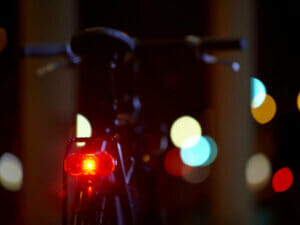
As nice as it is to cycle by day beneath a brightly shining sun, it’s really nothing more than a pipe dream, especially in Britain. British cyclists are all too often forced to ride in foggy and rainy conditions, and if you’re a cycle commuter, you most certainly have to ride at night, so dealing with poor visibility is the order of the day for majority of you.
With that in mind, it is incredibly important to have the best bike lights. And, since there are so many to choose from, we thought it’d be helpful to break down the rules and regulations as well as the most essential features for you.
The Road Vehicles Lighting Regulations (RVLR)

According to the Road Vehicles Lighting Regulations (RVLR), every bike must have 1) a white light showing from the front, 2) a red light showing from the rear as well as 3) reflectors, a white one in the front and a red one in the rear. Other reflectors not required by the RVLR include the yellow or white reflectors on the sides of the wheels. It’s a good idea to keep these on, though, as they make your bike more visible at night. That’s something we like to forget: bike lights are not just there to enable us to see where we’re going but also makes us visible to other road users.
Simply put: your bike needs lights. That’s all well and good, but what kind of lights? Well, first of all, you need to know what kind of bike you ride. Fortunately, most city and trekking bikes often come with hub dynamos and lights already built in. Road bikes and mountain bikes, however, usually require action on your part.
So, the question is: what kind of light would you rather go with?
Hub dynamos or battery-powered lights?
Let’s keep this simple: If you have a bike with a dynamo, then you should use it to power your light. After all, a good hub dynamo is low maintenance and smooth-running. Whenever you need the light, all you have to do is switch it on. When you don’t, it’ll be there for when you do. You won’t even notice it. Hub dynamos seem to be the most widespread type of dynamos now, but spoke dynamos and bottle (or sidewall) dynamos can be used as well.
If your bike doesn’t have a dynamo and you’d prefer not to have one for whatever reason, your only other option is to use a battery-powered light. The advantage here is that they are relatively inexpensive and easy to mount on your bike. The disadvantage is, of course, that you’ll always have to make sure that the batteries are charged enough for you to arrive at your destination safely. So, you may be forced to take a replacement battery with you, which can be a bugger.
Regardless of whether you opt for battery-powered lights or hub dynamos, there are several factors you need to consider. So, on with the buyer’s guide!
Light output – the more the better?

The most fundamental characteristic of a light is certainly how bright it is.
Many manufacturers use lux to indicate the light intensity level. The normal amount seems to be around 40 to 80 lux. Of course, not all lights have the same output. There are lights out there that throw out significantly more or less lux (e.g., the Lupine Betty R with 4500 lumens, which at a distance of 5 metres and a beam angle of 35° is equal to 495 lux).
Despite the high output some lights have, it’s important to know that some lights may not permitted for use on the roads, as they can dazzle other road users. When flying downhill, brighter lights are an absolute must, though.
However, even the brightest light can be pretty useless if the light is not distributed accordingly. There are lights that have a wide beam, lighting up the area directly in front of the bike, and those that cast beams on objects that are further away. Unfortunately, manufacturers don’t provide any information on this, as it is very difficult to measure. However, there are several articles online that compare and contrast different models. Plus, there are all sorts of photos and videos on lights that provide insight into almost every bike light on the market.
But, before you start comparing each and every light out there, allow us to give you a couple more pointers to make your search easier!
Stand-light
Battery-powered lights only last until you shut them off or the battery dies. If you power your light with a dynamo, your light will shut itself off once the bike has stopped moving. This can obviously cause some problems in traffic. After all, it’s not all that uncommon to have to stop at a red light! One such problem is the fact that once the light’s off, you’re practically invisible to other road users. But, worry not! Manufacturers have heard our cries and developed something called a stand-light. This is a built-in capacitor that continues to power your light once the dynamo stops doing so. Thus, your light will stay on for a brief period of time, even once you stop moving! Pretty nifty, is it not? However, this capacitor usually only powers one LED, but that’s enough to remain visible to others in traffic.
So, when perusing bike lights, be sure to buy one with a stand-light feature.
Mounts

Battery-powered lights can be attached to your bike by way of a mount. The mount should be as stable as possible because if it’s wobbly, the light may shift or fall off the bike completely as a result of the slightest bump, jerk, etc. You wouldn’t want to have to readjust your light every time you ride over a kerb, right? A good company to go with is Busch & Müller, who is known for manufacturing very durable and stable mounts and lights.
USB port
As mentioned before, a hub dynamo generates power as soon as it moves. During the day, the light is usually off, so any power generated by the dynamo simply goes unused. What a waste! Fortunately, there are manufacturers out there who install little devices in their lamps that make this power useable. For example, Busch & Müller have designed the Lumotech IQ2 Luxos, which comes equipped with a built-in USB port you can use for your smartphone, GPS device, MP3 player or other compatible electronic devices. Of course, the charging power yielded by these devices pales in comparison to what you would get at home, but at least the power doesn’t go completely unused.
Note: If you’d like to use your dynamo primarily for generating electricity, we recommend using devices specifically designed for this purpose, such as the Busch & Müller E-Werk along with a backup battery.
A bike light’s most important feature
Just because a light can be mounted on your bike doesn’t mean that it complies with UK standards. The good thing is that, in most cases, you can safely assume that any bike lights you buy from a reputable dealer inside the UK do comply with the standards put forward by the Road Vehicles Lighting Regulations.
Conclusion
There is a wide variety of lights for bikes, which can make the search quite daunting, but don’t let that get you down! Since bike lights are usually tailored to a specific discipline, such as mountain biking or road cycling, you can filter out the ones you have no use for fairly easily. Also: remember the brightness of a light’s beam isn’t as important as you may think; it’s much more important to have a good distribution of light than an extremely bright beam.
If you have any questions, feel free to ask our experts in customer service. They are available during the week from 9 a.m. till 4 p.m. and can be reached by phone at 03 33 33 67058 or via e-mail.



